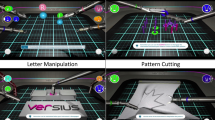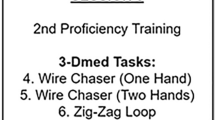Abstract
Background
The use of simulation for minimally invasive surgery (MIS) skills training has many advantages over current traditional methods. One advantage of simulation is that it enables an objective assessment of technical performance. The purpose of this study was to determine whether the ProMIS augmented reality simulator could objectively distinguish between levels of performance skills on a complex laparoscopic suturing task.
Methods
Ten subjects — five laparoscopic experts and five laparoscopic novices — were assessed for baseline perceptual, visio-spatial, and psychomotor abilities using validated tests. After three trials of a novel laparoscopic suturing task were performed on the simulator, measures for time, smoothness of movement, and path distance were analyzed for each trial. Accuracy and errors were evaluated separately by two blinded reviewers to an interrater reliability of >0.8. Comparisons of mean performance measures were made between the two groups using a Mann-Whitney U test. Internal consistency of ProMIS measures was assessed with coefficient α.
Results
The psychomotor performance of the experts was superior at baseline assessment (p < 0.001). On the laparoscopic suturing task, the experts performed significantly better than the novices across all three trials (p < 0.001). They performed the tasks between three and four times faster (p < 0.0001), had three times shorter instrument path length (p < 0.0001), and had four times greater smoothness of instrument movement (p < 0.009). Experts also showed greater consistency in their performance, as demonstrated by SDs across all measures, which were four times smaller than the novice group. Observed internal consistency of ProMIS measures was high (α = 0.95, p < 0.00001).
Conclusions
Preliminary results of construct validation efforts of the ProMIS simulator show that it can distinguish between experts and novices and has promising psychometric properties. The attractive feature of ProMIS is that a wide variety of MIS tasks can be used to train and assess technical skills.









Similar content being viewed by others
References
Darzi A, Smith S, Taffinder N (1999) Assessing operative skill. BMJ 318: 887
Datta V, Mackay S, Mandalia M, Darzi A (2001) The use of electromagnetic motion tracking analysis to objectively measure open surgical skill in the laboratory-based model. J Am Coll Surg 193: 479–485
Gallagher A, Satava R (2002) Virtual reality as a metric for the assessment of laparoscopic pyschomotor skills. Surg Endosc 16: 1746–1752
Gallagher A, Lederman A, McGlade K, Satava R, Smith CD (2004) Discriminative validity of the Minimally Invasive Surgical Trainer in Virtual Reality (MIST-VR) using criteria levels based on expert performance. Surg Endosc 18:660–665
Grantcharov T, Kristiansen V, Bendix J, Bardram L, Rosenberg J, Funch-Jensen P (2004) Randomized clinical of virtual reality simulation for laparoscopic skills training. Br J Surg 91: 146–150
Kothari S, Kaplan B, DeMaria E, Broderick T, Merrell RC (2002) Training in laparoscopic suturing skills using a new computer based virtual reality simulator (MIST-VR) provides results comparable to those with an established pelvic trainer system. J Laparoendoscop Adv Surg Tech 12: 167–173
Pearson A, Gallagher A, Rosser J, Satava R (2002) Evaluation of structured and quantitative training methods for teaching intracorporeal knot tying. Surg Endosc 16: 130–137
Reznick R, Regehr G, MacRae H, Martin J, McCulloch W (1997) Testing technical skill via an innovative “bench station” examination. Am J Surg 173: 226–230
Rosser J, Rosser L, Salvagi R (1997) Skill acquisition and assessment for laparoscopic surgery. Arch Surg 132: 200–204
Satava R (1993) Virtual reality surgical simulator: the first steps. Surg Endosc. 7: 203–205
Satava R (1999) The need for metrics in surgical education. Surg Endosc 13: 1082
Schijven M, Jakimowicz J (2003) Virtual reality surgical laparoscopic simulators. Surg Endosc 17:1943–1950
Seymour N, Gallagher A, Roman S, O’Brien M, Bansal VK, Andersen DK, Satava RM (2002) Virtual reality training improves operating room performance: results of a randomized, double-blinded study. Ann Surg 236: 458–463
Smith S, Torkington J, Brown T, Taffinder NJ, Darzi A (2001) Motion analysis: a tool for assessing laparoscopic dexterity in the performance of a laboratory-based laparoscopic cholecystectomy. Surg Endosc 16: 640–645
Taffinder N, Smith S, Mair J, Russel R, Darzi A (1999) Can a computer measure surgical precision? Reliability, validity and feasibility of the ICSAD. Surg Endosc 13(Suppl 1): 81
Villegas L, Schneider BE, Gallery MP, Jones UB (2003) Laparoscopic skills training. Surg Endosc 17: 1879–1888
Author information
Authors and Affiliations
Corresponding author
Rights and permissions
About this article
Cite this article
Van Sickle, K.R., III, D.A.M., Gallagher, A.G. et al. Construct validation of the ProMIS simulator using a novel laparoscopic suturing task. Surg Endosc 19, 1227–1231 (2005). https://doi.org/10.1007/s00464-004-8274-6
Received:
Accepted:
Published:
Issue Date:
DOI: https://doi.org/10.1007/s00464-004-8274-6




